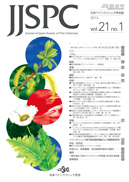Volume 20, Issue 1
Displaying 1-15 of 15 articles from this issue
- |<
- <
- 1
- >
- >|
-
2013Volume 20Issue 1 Pages 1-7
Published: 2013
Released on J-STAGE: March 22, 2013
Advance online publication: February 26, 2013Download PDF (299K)
-
2013Volume 20Issue 1 Pages 8-11
Published: 2013
Released on J-STAGE: March 22, 2013
Advance online publication: February 26, 2013Download PDF (233K) -
2013Volume 20Issue 1 Pages 12-16
Published: 2013
Released on J-STAGE: March 22, 2013
Advance online publication: February 26, 2013Download PDF (263K)
-
2013Volume 20Issue 1 Pages 17-23
Published: 2013
Released on J-STAGE: March 22, 2013
Advance online publication: February 26, 2013Download PDF (319K)
-
2013Volume 20Issue 1 Pages 24-27
Published: 2013
Released on J-STAGE: March 22, 2013
Advance online publication: February 26, 2013Download PDF (252K) -
2013Volume 20Issue 1 Pages 28-31
Published: 2013
Released on J-STAGE: March 22, 2013
Advance online publication: February 26, 2013Download PDF (244K) -
2013Volume 20Issue 1 Pages 32-35
Published: 2013
Released on J-STAGE: March 22, 2013
Advance online publication: February 26, 2013Download PDF (259K) -
2013Volume 20Issue 1 Pages 36-39
Published: 2013
Released on J-STAGE: March 22, 2013
Download PDF (236K) -
2013Volume 20Issue 1 Pages 40-43
Published: 2013
Released on J-STAGE: March 22, 2013
Advance online publication: February 26, 2013Download PDF (289K) -
2013Volume 20Issue 1 Pages 44-47
Published: 2013
Released on J-STAGE: March 22, 2013
Advance online publication: February 26, 2013Download PDF (311K) -
2013Volume 20Issue 1 Pages 48-51
Published: 2013
Released on J-STAGE: March 22, 2013
Advance online publication: February 26, 2013Download PDF (244K) -
2013Volume 20Issue 1 Pages 52-55
Published: 2013
Released on J-STAGE: March 22, 2013
Advance online publication: February 26, 2013Download PDF (248K) -
2013Volume 20Issue 1 Pages 56-59
Published: 2013
Released on J-STAGE: March 22, 2013
Advance online publication: February 26, 2013Download PDF (235K)
-
2013Volume 20Issue 1 Pages 60-68
Published: 2013
Released on J-STAGE: March 22, 2013
Download PDF (330K)
-
2013Volume 20Issue 1 Pages 69-78
Published: 2013
Released on J-STAGE: March 22, 2013
Download PDF (512K)
- |<
- <
- 1
- >
- >|
